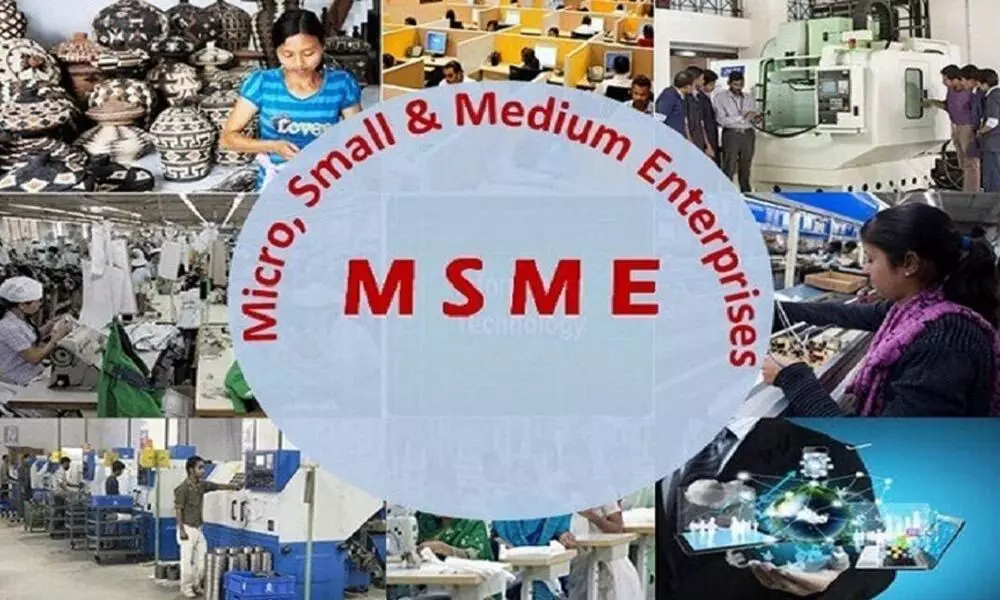MSME sector fares better than large corporates in loan repaying
MSME NPA rate at 12.5% is better than large corporates’ 19.7%
image for illustrative purpose

Mumbai: Contrary to popular belief, the largely unorganized and underserved MSME sector turned out to be a better bet for lending, than large corporates. At a NPA rate of 12.5 per cent they were significantly better than large corporates who had a NPA rate of 19.7 per cent. The total lending of Rs 64.45 lakh crore (as of January 2020) to businesses in India, of which MSMEs accounted for Rs 17.75 lakh crore credit exposure.
The Deployment of Gross Bank Credit to MSMEs and outstanding as on 31 Dec, 2021 was Rs 4,47,566 crores, up from Rs 3,87,220 crores as on 26 Mar, 2021.
Talking to Bizz Buzz, Gurjodhpal Singh, CEO, Tide, says: "With the first woman-led start-up to go public in 2021 and women SMEs seeing a 75 per cent growth in number, we have definitely come a long way. This marks good progress made by the government, regulators, and the ecosystem as a whole. It is also, imperative that we continue to build on this momentum, by working towards addressing the challenges that still face women-led small businesses like lending, peer training and networking, financial inclusion as well as help them overcome social and cultural barriers."
The fact that there are just 70.64 crore accounts (out of 211.65 crore) in scheduled commercial banks, that belong to women account holders, which is just 30 per cent (as per data available with the Reserve Bank of India, as of March 31, 2021) speaks volumes of the need for digitisation and financial inclusion, especially among women-led businesses, he added.
The MSME sector contributes 30 per cent to the national GDP and 45.9 per cent to the total exports by the country. However, despite this impressive numbers Brick-and-mortar banks cover hardly 15 per cent of the total MSMEs in India and a large section of this segment remains out of the purview of banking network in the country. Hence, it has been found that promoters of more than 22 million MSMEs in India must depend on their own funds or loans from friends and families for the capital requirement. Such sources remain often inadequate or expensive.
These are some major findings of a report titled MICRO, SMALL AND MEDIUM ENTERPRISES (MSMES): CHANGING LANDSCAPE released by Infomerics Valuation and Rating Pvt Ltd., the well-known SEBI-registered and RBI-accredited financial services credit rating company. The report also mentions that MSME segment in India is facing a huge addressable credit gap which is Rs 25.8 trillion and growing 37 per cent CAGR. Total addressable market demand by the MSME sector is approximately Rs 37 trillion. Banks, other institutions, and NBFCs supplies to the MSME sector are about Rs 10.9 trillion.
As on February 24, there was 73,42,646 Udyam Registration, 42,660 projects (PMEGP), 5,97,569 proposals approved (CGTMSE), 2,790 Khadi Institutions (KVIC), 486 MSE CDP (CFC/ID Projects) and 3500 Export Target (Coir Board).
Over 6 crore MSME units in India employ about 11 crore people. There are many women-led enterprises in rural, urban, and semi-urban areas that contribute over 20 per cent of the total MSMEs with the scope for acting as a catalyst for economic growth across the geographic, social, and cultural strata of the country.
The Government of India has initiated additional support of Rs 1500 million in the existing kitty (Rs 3000 million) of credit guarantee funds (28 June 2021), access to non-bank credit, and expansion of eligible sectors (retail and wholesale trade with 2. 5 crores enterprises) to MSMEs.
The Union Budget 2022-23 provided a long-term vision for the MSME sector to flourish in the future. The digitization process in the sector is gaining momentum and now the sector needs to deliver and sell its products swiftly and efficiently. The budgetary allocation for MSMEs rose from Rs 15,699.65 crores in FY 2021-22 to Rs 21,422 in FY 2022-23 which is up by 26.71 per cent. The 59-minute loan portal was launched to enable easy access to credit for MSMEs, and in-principle approval of loans up to Rs. 1 crore. Until 31st December 2021, a total of 2,37,027 loans involving Rs 79,527 crores were sanctioned. Further, 2,20,664 numbers of loans, involving Rs 64,776 crores were disbursed.
The Government should focus on the formidable potential of enhancing the MSMEs' share in the total export and GDP of the country. MSMEs can contribute to higher exports and GDP. There are more than 63 million MSMEs in India covering 80 per cent of the industries in the country. MSMEs alone accounts for 30 per cent of GDP and 45.9 per cent of total exports of the country. The government through its policy support must explore the road ahead for the MSMEs to be a part of global value chains (GVCs) and attempt global integration. Going ahead, demand, scale, funding, delivery capacity, and productivity is of strategic significance for the steady growth and structural transformation of MSMEs in India.
Overcoming uncertainties in MSMEs through policy engagements requires a renewed thrust on financial inclusion, Fintech, risk assessment for MSMEs, empowering MSMEs through policies, industrial collaborations, and capacity building training.

